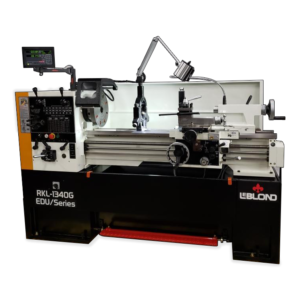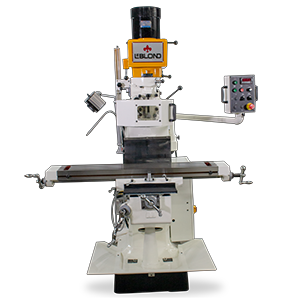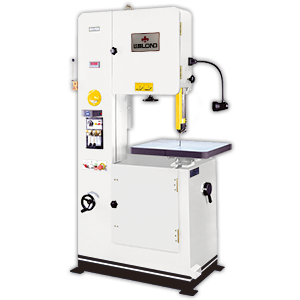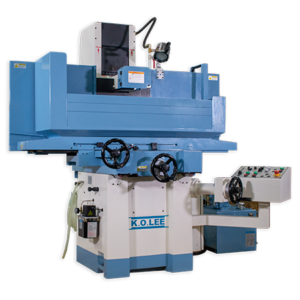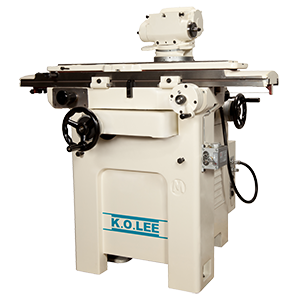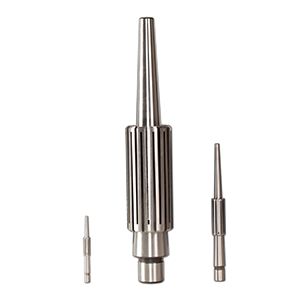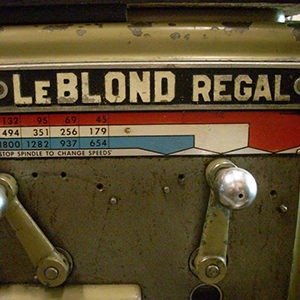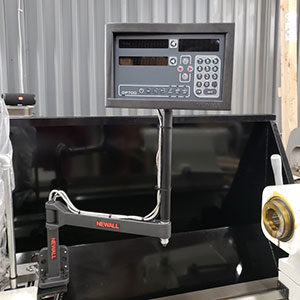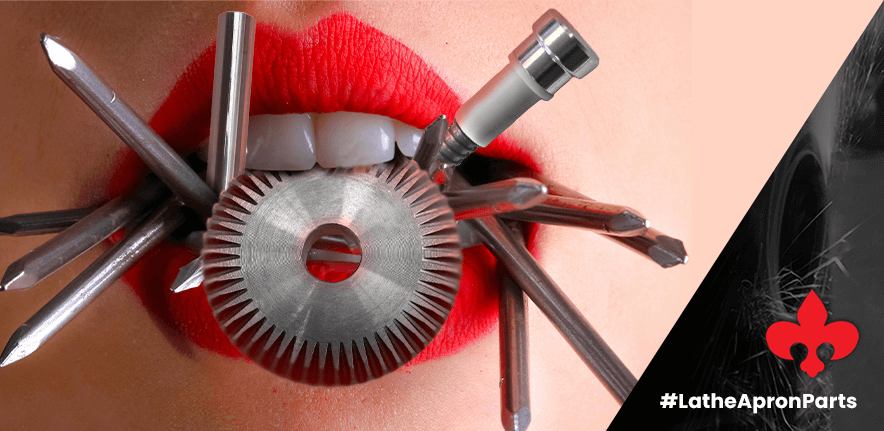“The teeth start to mash a little bit.”
That’s how Christopher Smith, LeBlond’s Service Manager, describes what happens when operators slam their lathe feeds too hard.
Those expensive gears you depend on? They’re getting destroyed one careless engagement at a time.
The Big Three That Keep Your Lathe Running
Your lathe apron has three critical components that separate precision cuts from scrap metal.
Rack and pinion gears. Beveled gear. Half nut.

These parts control everything. Your feeding. Your cross-slide cuts. Your threading operations. When they fail, your lathe becomes an expensive paperweight.
What These Parts Actually Do
The rack and pinion system moves your cutting tool along the bed.
The beveled gear changes direction and transfers power. Together, they give you the controlled feeding that makes clean cuts possible.
Think of them as the transmission for your cutting operations.

The half nut?
That’s your threading lifeline. It engages with the lead screw to cut precise threads. No half nut engagement means no threading capability.
Why Your Gears Are Failing
Here’s the brutal truth. These are soft gears.
Not hardened. Not bulletproof. Soft.
When operators slam the feed engagement too hard, the teeth get mashed. They stop meshing properly with each other. Eventually, they wear down so much that they don’t even make contact anymore.
Your feed stops working. Your cuts turn to garbage.
The Maintenance Reality
Maintaining these gears isn’t easy. They’re buried behind the apron where oil doesn’t naturally reach them.
But here’s what works.
Spray oil from any hardware store. Hit those gears occasionally to keep them lubricated. Spray grease works too if you prefer it.
Some guys hate WD-40. Fine. There are other options.
The point is getting lubricant back there before the teeth start grinding against each other.
Keep Your Feed Rod Clean
Your feed rod is exposed. That’s your advantage.
Wipe it down weekly with a shop rag. Keep your lead screw clean too. This prevents dirt and dust from migrating back to those hidden gears.
It’s simple maintenance that prevents expensive repairs.
When Gears Go Bad
You’ll hear it before you see it.
Chattering during cuts. Teeth jumping. Your nice clean cuts turn into chatter-marked disasters.
On newer lathes (post-1950s), you get bidirectional feeding. That means more complexity and more potential failure points.
Older lathes from the 1950s? Single direction only. Simpler systems, but the same maintenance principles apply.
Replacement Reality Check

How often do these gears need replacement?
Daily use with poor maintenance? Every 7-10 years.
Light use with proper care? You might get ten years before replacement becomes necessary.
The math is simple. Proper lubrication extends gear life. Neglect accelerates failure.
The Half Nut Situation

Your half nut handles threading operations by engaging the lead screw.
When it’s shot, you’ll know. The threads won’t pick up correctly during cutting operations. Your thread engagement becomes inconsistent or fails completely.
Replacement interval? About 10 years for daily use. Maybe 20 years for occasional operators.
Hand Pump Lubrication

Most lathes have a hand pump system. Use it.
The pump sends oil to the half nut through a dedicated tube. It also lubricates your bed ways and cross-slide.
Use Mobil DTE 26 or Performance Plus AW68. Available at automotive stores or through LeBlond directly.
The Brass Yoke Problem
Your hand lever for directional feeding has a brass yoke. Brass is soft metal that wears over time.
When the yoke wears out, you lose good engagement with your rack and pinion system. Feeding becomes inconsistent. The mechanism jumps out during operation.

Replacement timeline? Every 5-8 years under daily use. Maybe 10+ years for light use.
Maintenance Strategy
Keep oil flowing to moving parts. Use your hand pump system. Blow out chips with compressed air.
Wipe down exposed rods weekly. Apply spray lubricant to hidden gears when you remember to do it.
Clean beats fancy every time.
The Forklift Factor
Physical damage kills more lathe components than wear does.
Keep forklifts away from your equipment. Train operators to respect the machinery. A bent handle or damaged apron costs more than prevention ever will.
When Replacement Becomes Necessary

Don’t wait for complete failure.
Chattering cuts mean gear damage is already happening. Inconsistent thread engagement signals half-nut problems. Sloppy handle operation indicates worn bushings or yokes.
Address problems early. Replacement is easier than rebuilding destroyed components.
LeBlond’s Advantage

We stock OES parts for your lathe apron. Rack and pinion gears. Beveled gears. Half nuts. Brass yokes. Everything you need to keep your equipment running.
The Bottom Line
Your lathe apron parts are wearing out right now.
Proper lubrication extends their life. Clean operation prevents premature failure. Regular maintenance beats emergency repairs.
The choice is simple. Take care of your equipment or replace it more often.
Which path costs less?
Contact LeBlond For Lathe Apron Parts
If you need to order apron parts for your legacy LeBlond, please contact us:
- Find online parts ON THIS PAGE.
- Call +1 (888) 532-5663 (Monday-Friday 8am-4:30pm ET) & select Option 1.
- Or leave a comment below!
We look forward to hearing from you!

